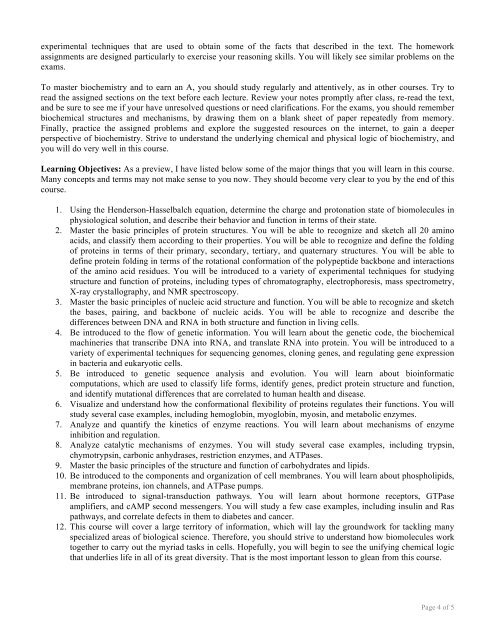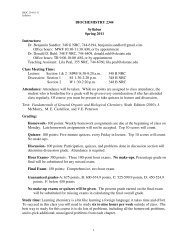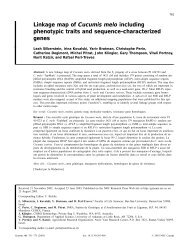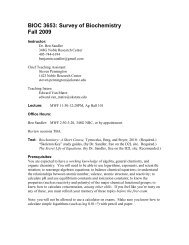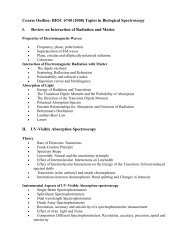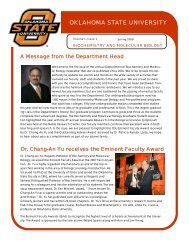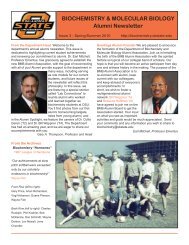BIOC 3713 - Biochemistry I - Biochemistry and Molecular Biology ...
BIOC 3713 - Biochemistry I - Biochemistry and Molecular Biology ...
BIOC 3713 - Biochemistry I - Biochemistry and Molecular Biology ...
You also want an ePaper? Increase the reach of your titles
YUMPU automatically turns print PDFs into web optimized ePapers that Google loves.
experimental techniques that are used to obtain some of the facts that described in the text. The homework<br />
assignments are designed particularly to exercise your reasoning skills. You will likely see similar problems on the<br />
exams.<br />
To master biochemistry <strong>and</strong> to earn an A, you should study regularly <strong>and</strong> attentively, as in other courses. Try to<br />
read the assigned sections on the text before each lecture. Review your notes promptly after class, re-read the text,<br />
<strong>and</strong> be sure to see me if your have unresolved questions or need clarifications. For the exams, you should remember<br />
biochemical structures <strong>and</strong> mechanisms, by drawing them on a blank sheet of paper repeatedly from memory.<br />
Finally, practice the assigned problems <strong>and</strong> explore the suggested resources on the internet, to gain a deeper<br />
perspective of biochemistry. Strive to underst<strong>and</strong> the underlying chemical <strong>and</strong> physical logic of biochemistry, <strong>and</strong><br />
you will do very well in this course.<br />
Learning Objectives: As a preview, I have listed below some of the major things that you will learn in this course.<br />
Many concepts <strong>and</strong> terms may not make sense to you now. They should become very clear to you by the end of this<br />
course.<br />
1. Using the Henderson-Hasselbalch equation, determine the charge <strong>and</strong> protonation state of biomolecules in<br />
physiological solution, <strong>and</strong> describe their behavior <strong>and</strong> function in terms of their state.<br />
2. Master the basic principles of protein structures. You will be able to recognize <strong>and</strong> sketch all 20 amino<br />
acids, <strong>and</strong> classify them according to their properties. You will be able to recognize <strong>and</strong> define the folding<br />
of proteins in terms of their primary, secondary, tertiary, <strong>and</strong> quaternary structures. You will be able to<br />
define protein folding in terms of the rotational conformation of the polypeptide backbone <strong>and</strong> interactions<br />
of the amino acid residues. You will be introduced to a variety of experimental techniques for studying<br />
structure <strong>and</strong> function of proteins, including types of chromatography, electrophoresis, mass spectrometry,<br />
X-ray crystallography, <strong>and</strong> NMR spectroscopy.<br />
3. Master the basic principles of nucleic acid structure <strong>and</strong> function. You will be able to recognize <strong>and</strong> sketch<br />
the bases, pairing, <strong>and</strong> backbone of nucleic acids. You will be able to recognize <strong>and</strong> describe the<br />
differences between DNA <strong>and</strong> RNA in both structure <strong>and</strong> function in living cells.<br />
4. Be introduced to the flow of genetic information. You will learn about the genetic code, the biochemical<br />
machineries that transcribe DNA into RNA, <strong>and</strong> translate RNA into protein. You will be introduced to a<br />
variety of experimental techniques for sequencing genomes, cloning genes, <strong>and</strong> regulating gene expression<br />
in bacteria <strong>and</strong> eukaryotic cells.<br />
5. Be introduced to genetic sequence analysis <strong>and</strong> evolution. You will learn about bioinformatic<br />
computations, which are used to classify life forms, identify genes, predict protein structure <strong>and</strong> function,<br />
<strong>and</strong> identify mutational differences that are correlated to human health <strong>and</strong> disease.<br />
6. Visualize <strong>and</strong> underst<strong>and</strong> how the conformational flexibility of proteins regulates their functions. You will<br />
study several case examples, including hemoglobin, myoglobin, myosin, <strong>and</strong> metabolic enzymes.<br />
7. Analyze <strong>and</strong> quantify the kinetics of enzyme reactions. You will learn about mechanisms of enzyme<br />
inhibition <strong>and</strong> regulation.<br />
8. Analyze catalytic mechanisms of enzymes. You will study several case examples, including trypsin,<br />
chymotrypsin, carbonic anhydrases, restriction enzymes, <strong>and</strong> ATPases.<br />
9. Master the basic principles of the structure <strong>and</strong> function of carbohydrates <strong>and</strong> lipids.<br />
10. Be introduced to the components <strong>and</strong> organization of cell membranes. You will learn about phospholipids,<br />
membrane proteins, ion channels, <strong>and</strong> ATPase pumps.<br />
11. Be introduced to signal-transduction pathways. You will learn about hormone receptors, GTPase<br />
amplifiers, <strong>and</strong> cAMP second messengers. You will study a few case examples, including insulin <strong>and</strong> Ras<br />
pathways, <strong>and</strong> correlate defects in them to diabetes <strong>and</strong> cancer.<br />
12. This course will cover a large territory of information, which will lay the groundwork for tackling many<br />
specialized areas of biological science. Therefore, you should strive to underst<strong>and</strong> how biomolecules work<br />
together to carry out the myriad tasks in cells. Hopefully, you will begin to see the unifying chemical logic<br />
that underlies life in all of its great diversity. That is the most important lesson to glean from this course.<br />
Page 4 of 5


